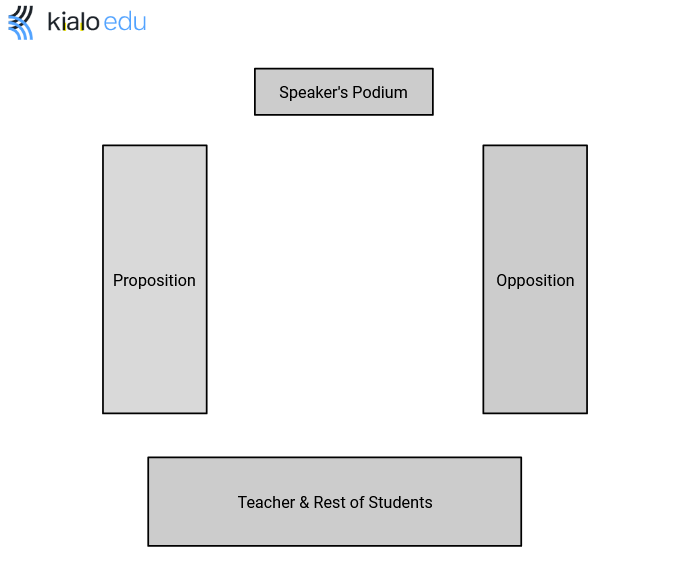Should Euthanasia be Legalized?
Ages: 15-18
Suggested length: 3-5 class periods (45-55 minutes each)
Device accessibility: 1 device per 2 students
Lesson Information
At a glance
This Kialo Edu discussion examines arguments for and against the legalization of euthanasia. Students will work in groups of 6 or 8, split into 2 even teams, to prepare and conduct a debate.
Learning objective(s)
In this lesson, students will:
- Analyze arguments for and against the legalization of euthanasia.
- Work collaboratively to construct persuasive arguments.
- Deliver persuasive arguments orally.
Prior knowledge
No specific prior knowledge is required for this lesson.
Teacher preparation
- There is no need to clone this discussion. Students can explore the discussion hosted on the Kialo Edu account by clicking this link.
- If you would like to invite students to the discussion using the Share button or the Teams feature, create 1 clone of the discussion for yourself.
- When inviting students to the discussion, give them Viewer permissions.
- If necessary, review some vocabulary related to euthanasia. Links to definitions can be found in the background information section of the Kialo discussion.
Provided materials
- The Kialo discussion, “Should Euthanasia be Legalized?” This includes:
- A brief background on euthanasia.
- A series of help links for students who may require support with personal circumstances.
- A fully developed Kialo discussion for students to explore in depth. The discussion covers the main arguments for and against legalizing euthanasia.
- Lesson plan for educators (.docx / .pdf).
- Instructions for students (.docx / .pdf).
- Graphic organizers for students to prepare for the class debate (.docx / .pdf).
- Suggested rubric for grading a class debate (.docx / .pdf).
- Suggested rubric for grading a writing assignment (.docx / .pdf).
- Download all offline materials (.zip).
Lesson Plan
Suggested length: 3-5 class periods (45-55 minutes each)
Lesson components:
– Opener (10-15 minutes)
– Activity
– Part A: Preparing for the class debate (focus of 2-3 class periods).
– Part B: Conducting the debates (focus of 1-2 class periods).
– Optional closer (10 minutes)
Assessment:
Students will be assessed on their performance and arguments during the debate.
If you opt to have student judges, these students can be assessed on a written composition, in which they state the reasons for their vote and how they might have argued any points differently than the students who directly participated in the debate.
See suggested rubrics for both assessments in provided materials.
- This lesson plan suggests debate teams of 3-4 students, as our experience in conducting class debates suggests that this is optimal. The lesson plan also suggests a method for holding 2 debates simultaneously to economize class time. However, feel free to modify the debate instructions as you see fit for your class.
- Encourage students to use a piece of paper to communicate with teammates during the debate, so that they do not interrupt the speaker and waste time.
- Expect a 3-on-3 debate to take approximately 22 minutes. Expect a 4-on-4 debate to take just under 30 minutes.
Opener (10-15 minutes)
- Share the article “Canada opens door to expanding assisted dying” with the class and direct students to read it.
- Explain that several countries, including Switzerland, Spain, and the Netherlands, as well some US states, have legalized euthanasia for the terminally ill.
- Explain that students will hold a structured debate regarding whether euthanasia should be legal in such cases.
Activity
Part A: Preparing for the class debate (focus of 2-3 class period)
- Distribute and go over the student instructions and assignment rubric(s).
- Divide the students into groups of 6 or 8, and split each group into 2 teams: pro-euthanasia and anti-euthanasia.
If your class size means that you will have some teams of 3 and some teams of 4, try to ensure that individual debates will be 3-on-3 or 4-on-4. It is ok if a debate must be 3-on-4; just ensure that the team with more speakers goes first.
If any students in your class do competitive debating as an extracurricular activity, it may be best to keep them as judges and have them conduct deliberations. That way, the resulting debates are fairer.
- Distribute and go over the graphic organizer.
- Students prepare for the debate by exploring the Kialo discussion and filling out the graphic organizer with their teams.
Optional extension (5 min): To avoid wasted time on the day of the trial, you can review the debate procedure during the class period prior to the debates.
Part B: Conducting the debates (1-2 class periods)
- To conduct 2 debates simultaneously and economize class time, you can:
- Hold both debates in the same noise-dampening space, like a cafeteria or outside, OR
- Hold one debate in your classroom and hold the other in a separate room.
- Set up the classroom(s) for a debate:

- Begin the debate(s).
- You should watch and assess one of the debates as it happens. Direct students in the other debate to make a video recording, so you can assess these students later.
- After the debate is finished, all judges have a 5-minute deliberation and decide which team has won the debate. One judge should provide a quick justification for the decision.
Optional extension: The winners of the two simultaneous debates can have their own “final” debate, in front of the whole class during a subsequent class period. This would require a total of four teams initially.
Optional closer (10 minutes)
- Have a class discussion on what students actually think about the main thesis: Should euthanasia be legalized? What are the risks and are they “worth it?”